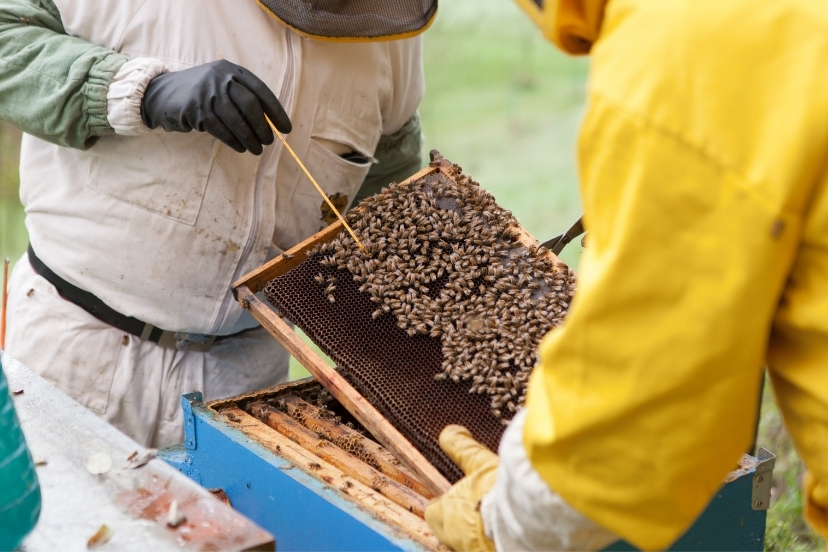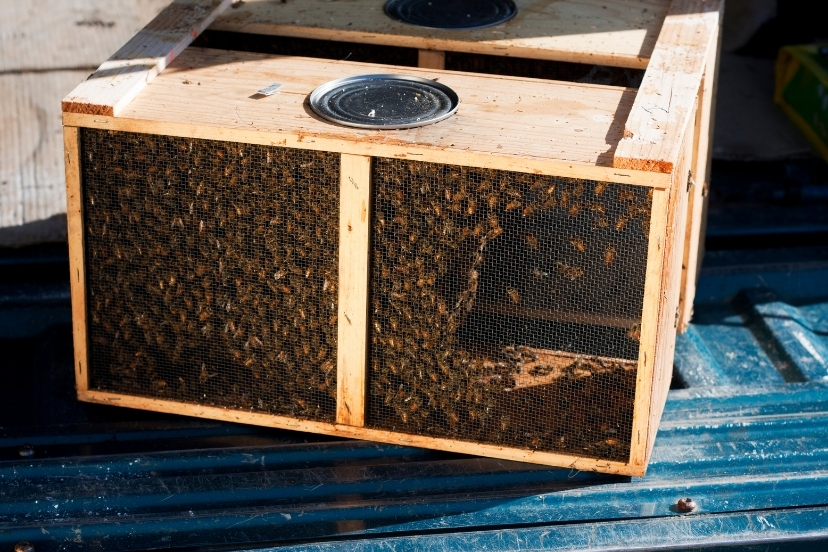Can the bee hive get too hot?
by Mary Aldrich
(Columbia Missouri)
At the start of summer I saw the bees milling about on the front of the hive. Now they are more then one layer deep hanging out on the entire front of the hive and kind of dripping off the bottom.
—
Hi Mary,
That’s common behavior for bees in the heat of the summertime. They do that for 2 reasons:
1) Removing the body heat of all those bees from the interior of the hive helps them to keep the interior of the hive at the proper temperature.
2) In some locales (including mine) there’s not much nectar available for foraging during the hottest part of the summer – especially during severe droughts as we’re currently having in Texas. So there are lots of bees with little to do.
Instead of lounging around inside the hive adding to the congestion, all of those temporarily UNbusy bees hang around on the outside.
You ask if it’s possible for the beehive to get too hot, and the answer is yes. But, it’s really very rare, and I doubt that it gets hot enough in your climate for that to happen.
You may already know, but bees are amazingly efficient at cooling their hives. They distribute water droplets throughout the interior of the hive, and by fanning their wings, circulate air throughout the hive.
The air flowing over the water droplets evaporates the water, and the air is cooled through the process of evaporative cooling.
The bees actually air condition their hive!
You can help the bees cool their hive by adding an upper entrance during the heat of the summer. (You may already have one – couldn’t tell for sure in the photo).
An upper entrance makes it easier for the bees to circulate fresh air freely throughout the hive, and allows some of the warmth building up inside the hive to escape since warmer air always rises.
The upper entrance will also help to reduce congestion in the brood nest, since foragers will be able to come and go from the upper entrance. That way they don’t have to enter at the bottom of the hive and make their way through the brood nest up to where the honey is being stored.
An easy way to add an upper entrance is to just stagger the super above the brood nest, as in the photo below.
Hope this helps!
P.S. That’s a nice looking hive. Are you going to have a honey crop this year?
Comments for Can the bee hive get too hot?Jul 31, 2011
more on can bees get to hot
by: Anonymous
Hi again,
Sorry to pester you. I had recently asked about bees being too hot. Now I have another question.
I added a second deep @ a month ago and it looked almost completely drawn out so I added a super with a queen excluder.
I checked again a week ago and the second deep was chock full of bees and honey and capped brood. I was too hot and cranky to try and get to the lower deep and check it also.
Should I have checked that first lowest deep – is it ok to wait till things get a little cooler?
Also there was no activity going on in the super so I removed the queen excluder. I was wondering if there is a reason they hadn’t started working on the super yet? They seem to be out and about picking up pollen from the sunflowers in the front yard and the russian sage – but maybe that isn’t enough to keep them busy. I seem to have related pollen availability to more hive activity – but I could be quite wrong about this.
Also if all this beginner nonsense is in your book – just tell me and I’ll give you some peace.
Regards,
Mary
—-
Hi Mary,
Don’t worry about pestering me. If I were worried about being pestered I wouldn’t have started a website and invited questions 🙂
Let’s see, about not checking the bottom super…
When I make a hive inspection, I have a goal. Maybe to see how the queen is doing, maybe to check whether they need another super, maybe to see if honey is ready to harvest – maybe all of the above.
My philosophy is to accomplish my goal for the inspection with as little disturbance to the bees as possible. Sometimes the goal requires complete dismantling of the hive, and sometimes just a peek under the cover is sufficient.
So if you found out what you needed to know without going down to the bottom super, then that was enough. There’s no need to examine 100% of the hive every time just to be doing.
About no activity above the excluder…
I’m sure you’ve heard that some beekeepers call a queen excluder a honey excluder. That’s because bees are often hesitant to go above the super if they don’t have to – particularly if there’s nothing but foundation above the excluder.
My guess is that the bees didn’t start working above the excluder because they had lots of room in the second deep.
If the honey flow goes on long enough that they’ve got everything below the excluder jam-packed full, then they’ll start working above the excluder (if they haven’t decided to swarm instead).
(Just my personal experience, you understand).
(continued in part 2)
Jul 31, 2011
part 2
by: Anonymous
(Sorry about the interruption; comments are limited in length)
When you’re adding a super above an excluder, if you have some drawn comb in the super – even just one frame – that can help entice the bees to begin working in the super more quickly.
In case you didn’t know, capped honey tends to be a pretty good queen excluder. If you have a solid layer of capped honey across the top of a super/hive body, you can place an empty super over that with a fair degree of confidence that the queen won’t cross that honey barrier.
That’s not absolute, of course. But quite often, queens are hesitant to cross a honey barrier.
And the pollen that the bees are bringing in doesn’t necessarily indicate that a strong honey flow is still occurring. In my neck of the woods, honey flows are nil at this time of the year, (especially this year!), but the bees are still able to scrounge up some pollen.
Oh, and about my book – it’s intended for absolute beginners. Most of what it covers would be behind where you’re at now, so I don’t think it would be worth your money at this point.
You’re more than welcome to come here and ask questions when you need to. I’ll answer them if I can!
Think I covered everything you asked about, but if not, ask away.
Good luck!
Aug 02, 2011
more on the hot hive
by: Anonymous
Thanks for your answers – and you said something (swarm) that made me run to the books and i can’t find an answer. Swarm….i understand to look for some signs of it – but i am unprepared to deal with that as a first year keeper. I guess the question i have is – if i ‘think’ the hive is getting crowded – can i split it myself by using one of the deeps to start a new hive? If i did this would that brood box be able to make a new queen on their own?
I had been thinking that next spring I’d order a new queen and try this out assuming that at least one of the deeps would need a new queen..but in all honesty i have never been able to spot the queen – ever – i can’t find waldo in any of the kids books and i never really thought I’d be good at finding the queen – so far that’s been true.
I was thinking that I’ll pick up another set of deeps and frames and have them ready for the spring and just on hand in case things start to look suspicious.
As always – thanks – the Missouri state fair starts on August 11 and the bee keepers group will be there so you will be safe for a week or so.
Mary
—
Hi Mary,
Yes, you can indeed create new hives by splitting one. It’s very easily done. (If you have an older beekeeping book, look for the term “making increase.” That’s what it used to be called.)
This is best done in the early spring, but here’s how it works: pick a very strong hive, take out 2 to 4 frames of brood without shaking off the bees, and also (preferably) take out a couple frames of honey.
Put the frames in a new hive with the entrance reduced and temporarily blocked (green grass stuffed in the entrance). Add enough frames of foundation or drawn comb to fill the hive body.
It can also help to shake the bees from a couple of frames into the new hive to add to the population.
Be sure to provide sugar syrup for the new hive if you don’t have frames of honey you can give to it.
When doing this, you must be absolutely certain that:
1) The frames contain eggs, and not just brood in more mature stages (since new queens can only be raised from very young larvae). But it’s also helpful if there’s lots of capped brood that will emerge soon to augment the population of the new hive.
(continued below)
Aug 02, 2011
hive splits continued…
by: Anonymous
2) The queen is NOT on any of the frames you remove. You want the old queen to remain in the original colony. Yes, queens can be harder to find than Waldo! But when doing this, you must find her – or at least be certain she’s not on any of the removed frames. You’ll get better at spotting her with practice.
When this is done right, you can substantially reduce the risk of swarming in the old hive, and yet do little to reduce their potential of producing a good honey crop.
The new hive will raise a queen, and should be a good strong hive for the following season.
If you want the new hive to build up faster, and/or have more control over the genetics of the hive, you can order a new queen for the new hive instead of letting them raise their own.
And yes, it is possible to make a split by just putting one of the 2 deeps on a new stand, without bothering to find the queen. The hive body without a queen will raise a new queen. You just have to make sure that there are eggs in each of the hive bodies.
It’s an easy way to ‘make increase,’ but you’ll be less likely to make a good honey crop (unless your best honey flows are quite late in the season.)
Enjoy the fair!


